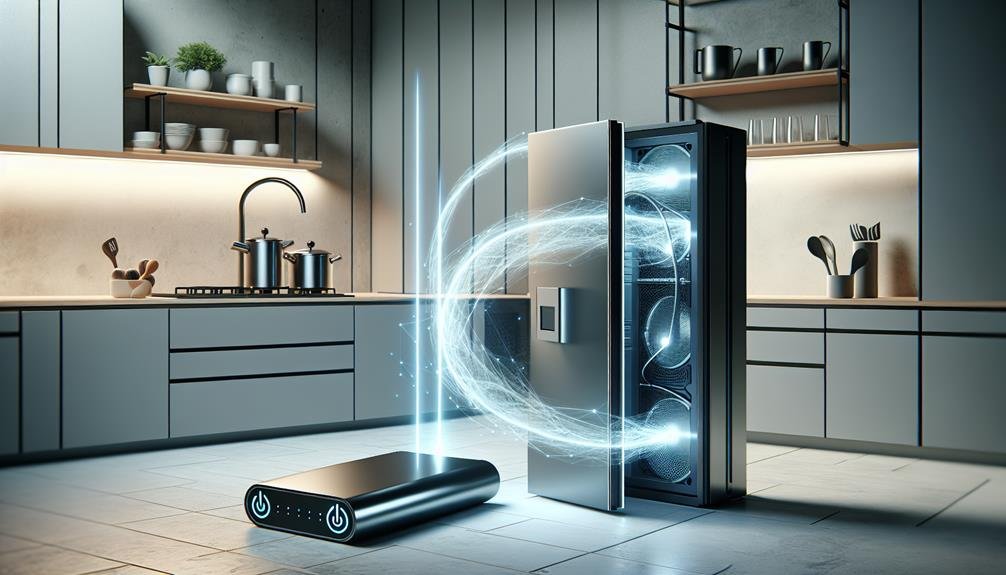You can power a freezer with a power bank, but it's complicated. Guarantee the voltage and amperage match, and confirm the power bank's capacity in watt-hours meets the freezer's energy demand. You'll likely need an inverter to handle the freezer's startup surge and continuous power draw. Proper wiring and connections are essential for safety. Test under realistic conditions to gauge runtime and performance. It's significant to balance the power bank's battery capacity with the freezer's consumption for best results. For a deeper technical understanding and practical insights, explore further details.
Understanding Power Banks
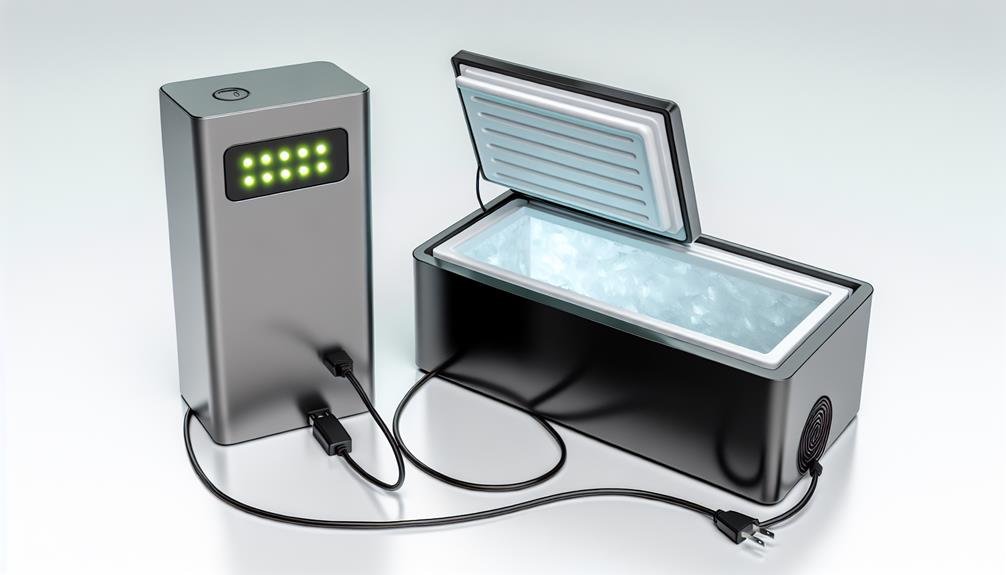
To understand power banks, you need to know that they are portable devices designed to store electrical energy and charge your electronic gadgets on the go. They're rechargeable batteries housed in a shell with input and output ports. These devices are incredibly handy for keeping your smartphones, tablets, and other small electronics powered up when you're away from a wall outlet.
However, it's essential to recognize the power bank limitations. Power banks come with varying capacities, typically measured in milliampere-hours (mAh). The higher the mAh, the more energy it can store, but this also means a larger and heavier device. While they're excellent for charging devices like phones and tablets, they may not have the necessary energy output to run larger appliances.
Safety is another vital consideration. Always use power banks that meet regulatory standards, and avoid overcharging them or exposing them to extreme temperatures. Overloading a power bank by trying to charge devices that require more power than the bank can supply could lead to overheating or even damage. Knowing these limitations guarantees you use them effectively and safely.
Freezer Power Requirements
Understanding the power requirements of a freezer is essential to determine if a power bank can be a reliable energy source. A typical household freezer's power consumption varies based on its energy efficiency, cooling capacity, and temperature control mechanisms. Generally, freezers consume between 100 to 800 watts, depending on their size and model.
Energy efficiency plays an important role in how much power your freezer will draw. Modern freezers with high energy efficiency ratings tend to consume less power while maintaining optimum cooling capacity. Look for models with Energy Star ratings, as these are designed to use less electricity without compromising on performance.
The cooling capacity of a freezer, often measured in BTUs (British Thermal Units), directly influences its power consumption. Higher cooling capacity units require more energy to maintain low temperatures, particularly in environments with fluctuating ambient temperatures.
Temperature control systems are another significant aspect. Freezers equipped with advanced temperature control technologies can maintain consistent internal conditions with minimal power draw. However, these systems also add to the overall power consumption.
Types of Freezers
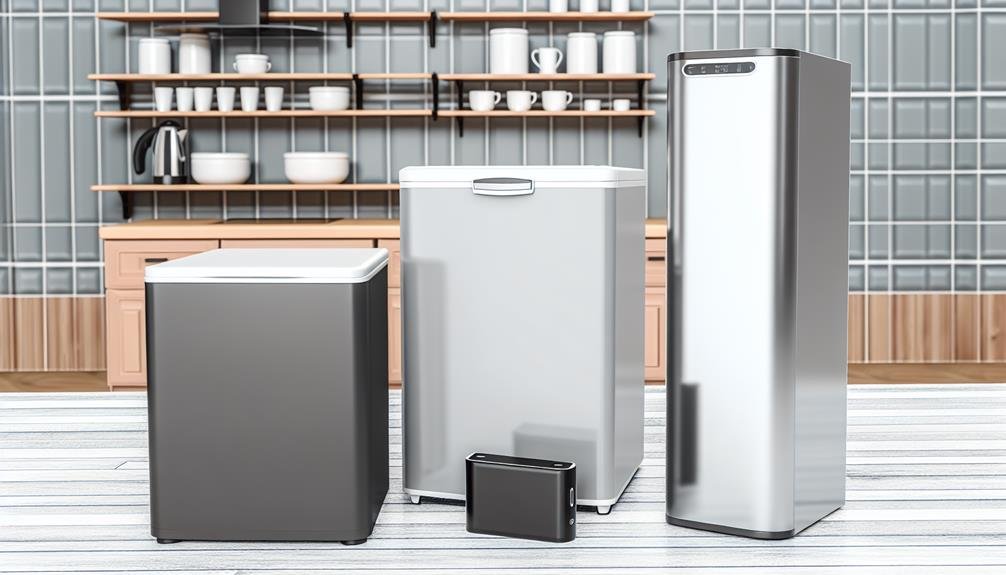
You'll need to weigh the differences between chest and upright freezers, as each has unique energy efficiency and storage benefits. Additionally, portable freezers offer flexibility for travel or limited space, while built-in freezers integrate seamlessly into kitchen designs. Understanding these distinctions will help you determine the most suitable option for your power bank-powered setup.
Chest Vs. Upright Freezers
When choosing between chest and upright freezers, it's essential to take into account factors like storage capacity, energy efficiency, and ease of organization. Chest freezers typically offer better energy efficiency due to their design. Their horizontal layout minimizes escaping cold air when opened. Conversely, upright freezers have a smaller footprint, making them ideal for tighter spaces but may consume more energy as cold air can escape more easily when the door is opened.
Chest freezers provide superior temperature control and often have more storage capacity variations. Their deep compartments can hold large items, and they maintain a more consistent temperature, which is pivotal for food safety. On the other hand, upright freezers offer easier organization with shelves and compartments, making it simpler to locate items.
Here's a quick comparison:
| Feature | Chest Freezer | Upright Freezer |
|---|---|---|
| Energy Efficiency | More efficient | Less efficient |
| Footprint | Larger footprint | Smaller footprint |
| Temperature Control | Consistent temperature | More fluctuations |
| Storage Capacity | Higher variations | Moderate variations |
| Ease of Organization | Harder to organize | Easier to organize |
| Ideal Use Case | Large items, bulk storage | Convenient access, small spaces |
Portable Vs. Built-In Freezers
In comparing portable and built-in freezers, it's important to evaluate factors like mobility, installation complexity, and integration with existing spaces. Portable freezers offer unparalleled convenience, allowing you to move them as required. They're ideal for camping trips or temporary storage needs. However, they often come with higher power consumption compared to built-in models. This can impact energy efficiency, especially if you plan to run the freezer on a power bank.
Built-in freezers, on the other hand, provide reliability and seamless integration into your existing kitchen layout. They require professional installation, which can be complex but guarantees the unit is securely fixed and optimized for energy efficiency. Built-in models generally consume less power because they are designed to run continuously within a controlled environment, contributing to long-term energy savings.
When considering safety, portable freezers should be placed on stable surfaces to prevent tipping, and their power cords must be checked regularly to avoid electrical hazards. Built-in freezers, being stationary, present fewer risks of physical accidents but require periodic maintenance to secure they operate efficiently and safely.
Ultimately, your choice between portable convenience and built-in reliability will depend on your specific needs, space constraints, and energy efficiency considerations.
Matching Voltage and Amperage
Understanding how to match voltage and amperage is crucial for guaranteeing your power bank can safely and efficiently power your freezer. First, you need to verify power bank compatibility. Not all power banks are designed to handle the high power demands of a freezer, so check the specifications carefully.
Next, focus on voltage matching. Most freezers operate at a specific voltage, often 12V or 24V for portable models. Your power bank must match this voltage to prevent damaging either the freezer or the power bank. Using a power bank with a higher or lower voltage can lead to inefficiency or even harm the appliance.
Here are three critical steps to guarantee safe and effective voltage and amperage matching:
- Check the Freezer's Requirements: Look at the freezer's manual or label to determine its voltage and amperage needs.
- Verify Power Bank Output: Guarantee the power bank's output voltage matches the freezer's requirement. For amperage, the power bank should provide at least the minimum required by the freezer.
- Use Appropriate Cables and Connectors: Ensure cables and connectors can handle the voltage and amperage without overheating or causing a short circuit.
Battery Capacity and Runtime
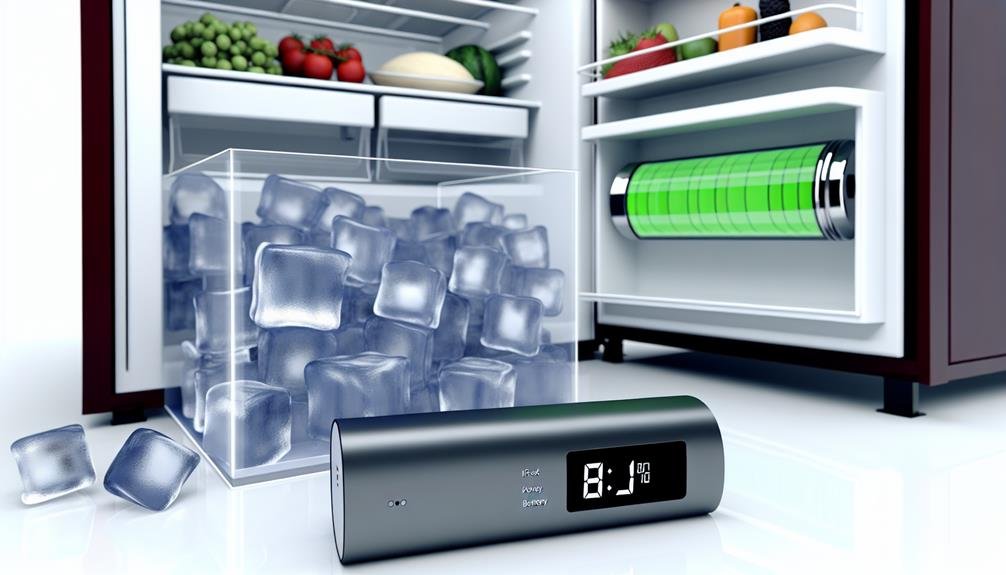
After ensuring the voltage and amperage are properly matched, it's equally important to calculate the power bank's battery capacity and expected runtime to maintain consistent operation for your freezer. To do this, you'll need to know the freezer's power consumption, typically stated in watts (W), and the power bank's capacity, usually measured in watt-hours (Wh) or milliamp-hours (mAh).
Let's break it down:
| Parameter | Value Example |
|---|---|
| Freezer Power Consumption | 100 W |
| Power Bank Capacity | 50000 mAh / 185 Wh |
| Expected Runtime | ~1.85 hours |
To estimate runtime, use the formula:
\[ ext{Runtime (hours)} = rac{ext{Power Bank Capacity (Wh)}}{ext{Freezer Power Consumption (W)}} \]
For instance, if your freezer consumes 100 W and your power bank's capacity is 185 Wh, the expected runtime is:
\[ rac{185\, ext{Wh}}{100\, ext{W}} = 1.85\, ext{hours} \]
Ensure the power bank's battery capacity is adequate for your needs. A higher capacity means longer runtime but also might imply greater weight and cost. Balancing battery capacity with your freezer's power consumption is essential for effective and safe operation. Always monitor the power bank's charge level to avoid unexpected shutdowns, and consider the efficiency losses in real-world conditions.
Inverter Necessities
You'll need to ensure the inverter can handle the freezer's startup surge and continuous power requirements to maintain its efficient operation. Freezers typically require a high surge of power at startup, which can be several times the running wattage. Ensuring the inverter can manage this surge is important for both performance and safety.
When considering inverter installation, keep these factors in mind:
- Surge Capacity: Verify the inverter's surge capacity is sufficient. For instance, if the freezer requires 800 watts to start but only 200 watts to run, the inverter must accommodate at least 800 watts during startup.
- Continuous Power Rating: The inverter should consistently supply the freezer's running wattage. Check the freezer's energy rating and ensure the inverter's continuous power rating exceeds this value.
- Power Bank Capacity: Match the power bank capacity with the inverter's requirements. A higher capacity power bank ensures longer operation times but must be compatible with the inverter's input specifications.
Proper inverter installation is essential for safety. Secure connections and appropriate wiring prevent hazards like overheating and short circuits. Follow manufacturer guidelines meticulously and consider professional installation if unsure. This attention to detail will extend the longevity of both your power bank and freezer while ensuring safe operation.
Real-World Testing
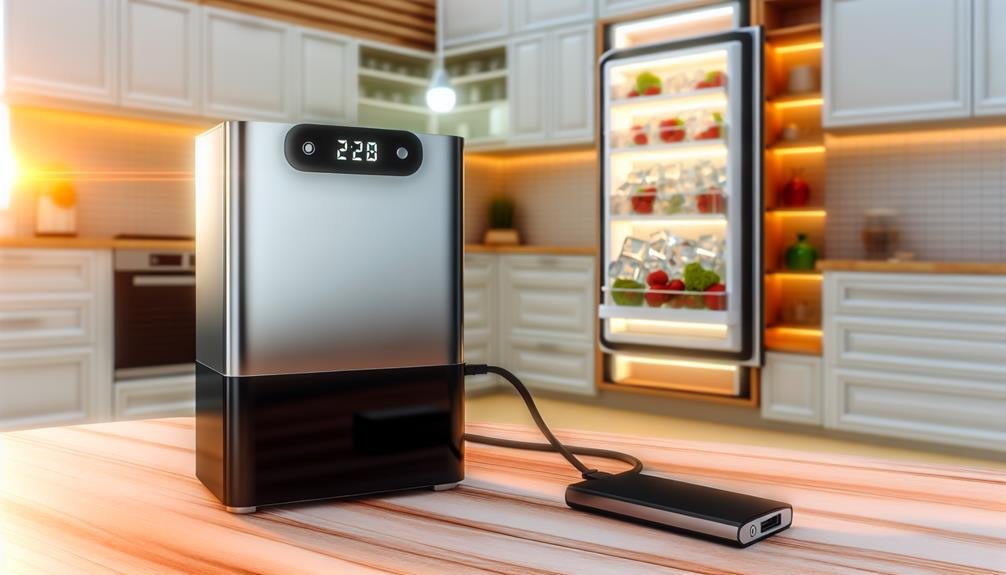
To understand the practical utility of your power bank-powered freezer, you'll need to conduct real-world testing. This involves evaluating the power duration, scrutinizing battery capacity, and examining performance under load conditions. Accurate data from these tests will help you determine operational efficiency and reliability.
Testing Power Duration
How effectively does the power bank maintain its charge when subjected to real-world conditions, such as variable temperatures and fluctuating usage patterns? Testing power duration involves understanding how power bank capacity and power bank output voltage affect overall performance. Here's a detailed analysis of the factors you need to ponder:
- Temperature Variations: Power bank capacity can be affected by extreme temperatures. In colder climates, the chemical reactions inside the battery slow down, reducing efficiency. Conversely, excessive heat can damage the battery, leading to a decrease in capacity and potential safety hazards.
- Fluctuating Usage Patterns: When your freezer's compressor cycles on and off, it creates varying demands on the power bank. The power bank's ability to maintain a stable output voltage during these fluctuations is essential. A consistent voltage ensures the freezer operates effectively without damaging internal components.
- Continuous Load Testing: To gauge the power duration accurately, you should conduct continuous load testing. This involves running the freezer continuously until the power bank is depleted. Monitoring the duration of this test provides a realistic measure of how long the power bank can sustain the freezer under constant load conditions.
Analyzing Battery Capacity
Evaluating battery capacity through real-world testing offers an insightful measure of how long the power bank can sustain the freezer's functionality under various conditions. To begin, you'll want to determine the freezer's power consumption, typically measured in watts. This information is vital for evaluating whether the power bank's battery efficiency can meet the freezer's energy demands.
When testing, use a power meter to monitor the freezer's energy draw. Record this data over a set period, ideally under different operating conditions, such as varying ambient temperatures. This will help you understand the power consumption patterns and how they affect battery life.
Next, calculate the power bank's total capacity, usually denoted in watt-hours (Wh). For example, a 100,000mAh power bank with a voltage of 3.7V has a capacity of approximately 370Wh. Compare this with the freezer's hourly power consumption to estimate how long the power bank can run the appliance.
It's essential to take into account battery efficiency, as real-world conditions often differ from theoretical calculations. Internal resistance, temperature, and discharge rates can all impact performance. By thoroughly analyzing these metrics, you can make sure the power bank's capacity meets your freezer's requirements safely and effectively.
Performance Under Load
After determining the freezer's power consumption and the power bank's capacity, the next step is to test the power bank's performance under real-world load conditions. Conducting load testing on power banks guarantees they can handle the continuous power draw required to keep the freezer operational. Here are the steps to follow:
- Initial Setup: Connect the power bank to the freezer and monitor the initial startup phase. This phase often requires a surge in power consumption, so make sure both devices are properly connected and grounded to avoid electrical hazards.
- Continuous Operation: Observe the freezer's performance over an extended period. Track the power bank's discharge rate and note if there are any fluctuations in the freezer's temperature. Consistent performance under load testing will indicate that the power bank is capable of sustaining the freezer's power needs.
- Safety Measures: Confirm the power bank has built-in safety features such as overcharge protection, short circuit prevention, and thermal management. This is essential to prevent any potential risks associated with prolonged use.
Practical Applications
In various real-world scenarios, power banks can be utilized to maintain the functionality of portable freezers, guaranteeing temperature-sensitive goods remain preserved during transit or in off-grid locations. However, it's important to understand power bank limitations. Most power banks are designed for low-wattage devices and may not provide sufficient power for extended freezer operation. Always check the power requirements of your freezer and match them with the power bank's output capabilities to avoid overloading.
For emergency cooling, a power bank can serve as a temporary solution. In the event of a power outage, a power bank can keep your portable freezer running for a limited period, safeguarding perishable items until a more stable power source is available. Prioritize using power banks with high-capacity batteries and multiple output ports to maximize efficiency.
When considering practical applications, make sure your power bank has built-in safety features like overcharge protection, short-circuit protection, and temperature control. This safeguards both the power bank and the freezer from potential damage. Regularly monitor the power bank's charge level to prevent unexpected shutdowns. By understanding these aspects, you can effectively use a power bank for portable freezer applications, ensuring both safety and functionality.
Frequently Asked Questions
How Do Temperature Settings Affect the Power Consumption of a Freezer?
Adjusting temperature settings directly impacts a freezer's power consumption. Lower settings enhance energy efficiency and freezer performance but may risk food safety. Higher settings guarantee safe storage but increase energy use, affecting overall efficiency.
Are There Specific Brands of Power Banks Recommended for Running Freezers?
Think of a power bank as a key to your freezer's lifeline. For power bank compatibility and energy efficiency, consider brands like Goal Zero or Jackery. Always prioritize models with high watt-hour ratings for safe, reliable operation.
Can Solar Power Banks Effectively Run a Freezer?
Solar power banks, with solar panel compatibility and sufficient battery capacity, aren't typically powerful enough to run a freezer. Despite their portability and usefulness for emergency preparedness, their output usually doesn't meet the high demands of freezers.
What Safety Precautions Should Be Taken When Using a Power Bank With a Freezer?
When using a power bank with a freezer, make sure the power bank's capacity matches the freezer's power consumption. Safety precautions include checking for overheating, avoiding water exposure, and using a surge protector to prevent damage.
How Does the Ambient Temperature Impact the Efficiency of a Power Bank Powering a Freezer?
Imagine your power bank as a marathon runner; temperature fluctuations can tire it out, reducing efficiency. High ambient temperatures increase energy consumption, impacting freezer performance. Maintaining a stable environment guarantees peak power bank efficiency and safety.

